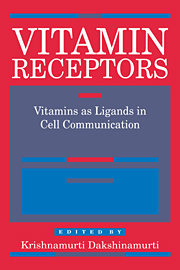Book contents
- Frontmatter
- Contents
- List of contributors
- Preface
- Introduction
- 1 Serum and cellular retinoid-binding proteins
- 2 Retinoic acid receptors
- 3 Vitamin D receptors and the mechanism of action of 1,25-dihydroxyvitamin D3
- 4 Cobalamin binding proteins and their receptors
- 5 Folate binding proteins
- 6 Riboflavin carrier protein in reproduction
- 7 Binding proteins for α-tocopherol, L-ascorbic acid, thiamine amd vitamin B6
- 8 Biotin-binding proteins
- List of abbreviations
- Index
8 - Biotin-binding proteins
Published online by Cambridge University Press: 06 January 2010
- Frontmatter
- Contents
- List of contributors
- Preface
- Introduction
- 1 Serum and cellular retinoid-binding proteins
- 2 Retinoic acid receptors
- 3 Vitamin D receptors and the mechanism of action of 1,25-dihydroxyvitamin D3
- 4 Cobalamin binding proteins and their receptors
- 5 Folate binding proteins
- 6 Riboflavin carrier protein in reproduction
- 7 Binding proteins for α-tocopherol, L-ascorbic acid, thiamine amd vitamin B6
- 8 Biotin-binding proteins
- List of abbreviations
- Index
Summary
Introduction
The discovery of biotin and the elucidation of its structure and role in metabolism involved diverse investigations spanning many decades. Isolation of crystalline biotin by Kogl & Tonnis (1936) and determination of its chemical structure and synthesis by Harris et al. (1943) were the highlights of the early history of research into this water-soluble vitamin. Biotin was shown to be cis-hexahydro-2-oxo-1H-thieno (3,4)imidazole-4-valeric acid (Figure 8.1a), with the (+) stereoisomer exhibiting significant biological activity. The role of biotin as the prosthetic group of the biotin-containing carboxylases was recognized in the 1960s. Biotin in most biological material was found to be protein-bound. Biocytin (biotinyl lysine) is released upon enzymatic digestion of biotin-containing proteins. It is cleaved by biotinidase into biotin and lysine (Figure 8.1b).
Biotin is covalently bound to a lysine residue of the carboxylases. The mechanism of action of biotin in the carboxylases is well understood (Lynen, 1967). This review focuses primarily on the non-covalent binding of biotin to various proteins. Such binding seems to be crucial to the uptake, transport and intracellular functions other than the prosthetic group function of this vitamin. Biotin-binding proteins of several species have been considered in relation to these functions.
Biotin-binding proteins have been classified into two groups: those proteins involved in biotin transport and those involved in recognizing biotin, resulting in a physiological function. In the category of transport proteins are the biotin-binding proteins of avian egg yolk as well as the animal biotinidase.
- Type
- Chapter
- Information
- Vitamin ReceptorsVitamins as Ligands in Cell Communication - Metabolic Indicators, pp. 200 - 249Publisher: Cambridge University PressPrint publication year: 1994
- 9
- Cited by

